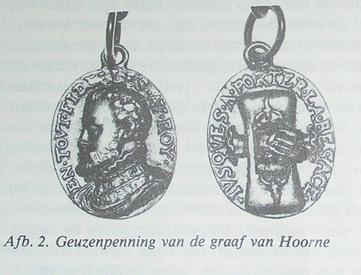Geuzen medals
In Dutch, geus (plural geuzen) is a familiar term for the people who revolted in the 16th century against the Spanish king Philip II.
After peace was made, Philip II appointed his half-sister Margaret of Parma as viceroy of the Low Countries and left for Spain.
Nobility such as William of Orange (or William the Silent, stadtholder [steward] of Holland, Zealand and Utrecht) and Lamoral, Count of Egmont, (stadthouder of Flandres) were members of the council, but were unhappy with their loss of power to Granvelle and because Spanish troops remained in the Low Countries after the peace with France.
Members of the lower nobility, who had been impoverished in previous decades (like the common people in the southern parts of the Low Countries) united in the 1565 Compromis; their political program sought relief from the Counter-Reformation.
On April 5, led by Hendrick van Brederode and Ludwig of Nassau, they presented a petition to Margaret (who was alarmed by the large gathering).
A dress code, with beggars' bowls and flagons and a silver (or gilt) token on a ribbon around the neck indicated their independence and dominance; mockery of the church may also have been a factor.
[citation needed] The medal is described in part I of Gerard van Loon's book, Beschrijving der Nederlandse Historipenningen ... (1713–1731), and has the collectors reference vL.I 85/84.5.
It shows the bust of Philip II, with "1566" on its cut[clarification needed] and the text "EN TOVT FIDELLES AV ROY" ("In everything loyal to the king"); on the reverse side is a beggar's sack, hands and the text, "IVSQVES A PORTER LA BESACE" ("even condemned to a beggar's level").
Morillon notes that Jonghelinck's neighbouring tourneur (a master furniture maker) turned small wooden bowls which women hung from their ears; original specimens are now unknown.
Early in the 17th century, when it became clear that the Dutch would win the Eighty Years' War, there was a growing demand for Geuzen medals.
A gold Geuzen medal reportedly belonged to Philip de Montmorency, Count of Horne, who was executed by the Duke of Alba in 1568.
The medal's text reads, "Liever Turks dan Paaps" ("Better Turkish than Papist") and "En DESPIT DE LA MES" ('In spite of the Mass').
The Duke of Alba, in his effort to strengthen the power of King Phillip II in the Low Countries, wanted to eliminate the bede (regular pleas for money by the state; this could only be done with taxation.
This cast-silver token has the collectors reference vL.I 157/155.1 and the qualification "very rare"; more frequently, it is found with a larger diameter and struck rather than cast.
In 1572, taxation on the tiende penning was prohibited and the Sea Beggars seized Den Briel for the Prince of Orange.
Vlissingen, Veere and Enkhuizen sided with the prince; a medal was struck on a cast-silver plate (originally without an eyelet), collectors reference vL.I 148/145 with the qualification "extremely rare".
The reverse shows two nobles, one with a beggar's bowl and flask and the other with a large Geuzen medal; the text reads, "Ivsqves a Porter La Besase"”.
After the pacification of Ghent, accepted by John of Austria, Jacques Jonghelinck produced a silver commemorative medal for casting in large numbers; the reference code is vL.I 243/230.







